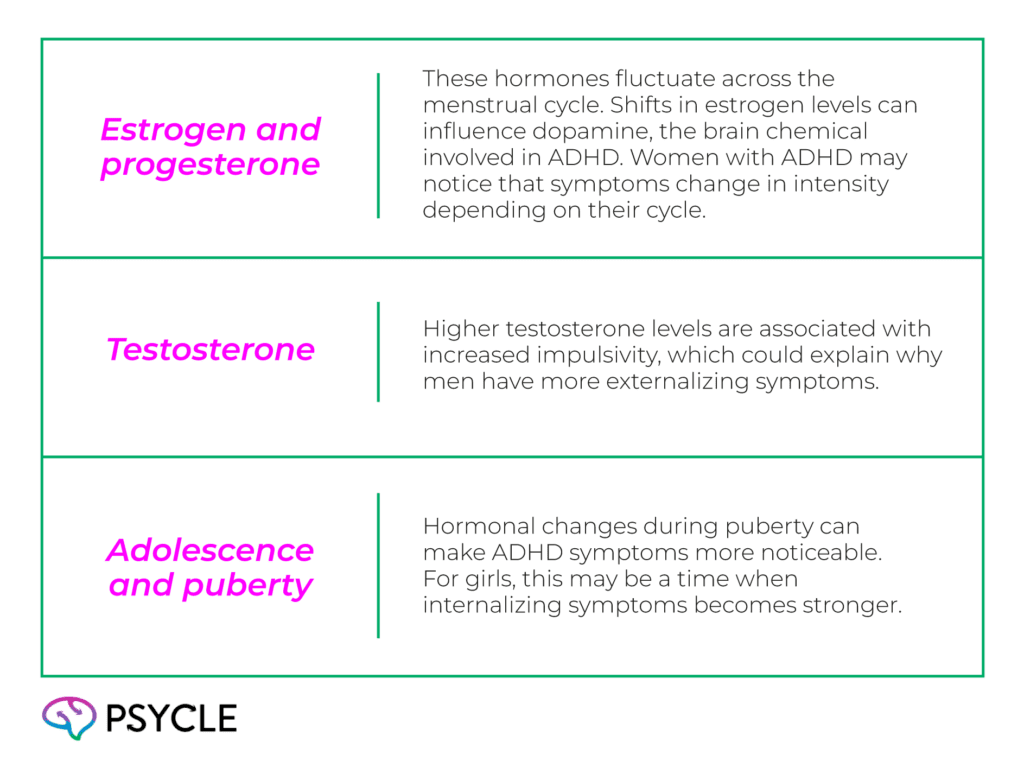Attention-deficit/hyperactivity disorder (ADHD) is one of the most widely studied conditions in mental health. It affects people of all ages and genders, but it does not look the same for everyone. Men and women often show different symptoms and experience various changes in ADHD over their lifespan.
In the article, we’ll compare how ADHD impacts men and women, and look at some of the science underlying these differences.
Key Takeaways
- ADHD is a neurodevelopmental condition that affects millions worldwide.
- Men and women often show different symptoms; men more often display hyperactivity and impulsivity, while women more often struggle with inattention and emotional challenge.
- ADHD in women is frequently misdiagnosed due to bias, symptom overlap, and masking behaviors.
- Biological factors, including hormones, influence how ADHD symptoms appear and change over time.
- ADHD symptoms shift across the lifespan.
- Support for ADHD includes professional evaluation, treatment, and strategies that improve daily life.
ADHD as a Global Challenge
ADHD is a neurodevelopmental condition that affects the way the brain manages attention, activity level, and impulse control. Doctors recognize three main types of ADHD based on the symptoms that show up most often:
- Predominantly Inattentive Type (ADHD-I): Main challenges include: trouble focusing, being easily distracted, forgetting things, losing items, struggling with instructions, and difficulty finishing tasks.
- Predominantly Hyperactive-Impulsive Type (ADHD-HI): Main challenges include fidgeting, restlessness, talking a lot, interrupting, acting without thinking, and difficulty waiting.
- Combined Type (ADHD-C): This is the most common type and includes both inattentive and hyperactive-impulsive symptoms.
Research shows that ADHD affects about 5–7% of children and about 2–3% of adults worldwide. It’s usually diagnosed in childhood, usually between the ages of 6 and 12, when school demands make symptoms more noticeable. Though it continues into adulthood, it can often go underdiagnosed in later life as adult symptoms tend to be less outwardly presenting.
Impact of ADHD
Living with ADHD affects many parts of life. School can feel especially difficult, and children may become frustrated and feel misunderstood by teachers. Many children with ADHD are labeled as “naughty,” which can lead to self-esteem issues that carry on into later life. In adulthood, ADHD often makes work more stressful and can strain both personal productivity and relationships.
ADHD Symptoms in Women vs. Men

Research shows that men and women often display different sets of symptoms. Men and boys more often show outward behaviors, known as externalizing symptoms. This includes:
- Hyperactivity
- Impulsivity
- Disruptive behavior in classrooms or workplaces
- Difficulty following rules or waiting for turns
On the other hand, women and girls often experience more inward struggles that may not be as visible. These internalizing symptoms include:
- Trouble paying attention and focusing on tasks
- Forgetfulness and disorganization
- Anxiety and overthinking
- Low self-esteem
- Mood swings or emotional sensitivity
These symptoms are sometimes mistaken for stress, anxiety, or depression, which is a major reason for ADHD often being underdiagnosed in women.
Why ADHD Is Often Misdiagnosed in Women
Many women live with ADHD for years before receiving a diagnosis. Several factors explain why.
- Gender bias in healthcare: ADHD research has historically focused on boys. This led to a narrow view of what ADHD looks like. Clinicians still use diagnostic criteria that reflect male patterns of behavior more than female ones.
- Overlap with other conditions: Women with ADHD often show symptoms that overlap with depression, anxiety, or mood disorders. A clinician may diagnose one of these conditions instead of ADHD.
- Masking and coping strategies: Many women learn to hide their difficulties. They may overcompensate by working harder, staying quiet, or organizing around their struggles. On the outside, they may appear fine, even when they are overwhelmed on the inside.
- Delayed recognition: Because teachers, parents, and clinicians often expect ADHD to look like hyperactivity, inattentive symptoms in girls are missed. This leads to underdiagnosis and delayed support.
Misdiagnosis can create extra problems. Women who go undiagnosed may feel confusion about their struggles, miss out on effective treatment, or develop secondary issues such as depression or burnout.
Biological Differences Between Women and Men with ADHD
Biology also plays a role in how ADHD shows up differently in men and women. Sex hormones influence brain chemistry, which can impact symptoms.

Understanding these biological factors helps explain why ADHD looks different between genders and why symptoms may change over time.
In both men and women, testosterone levels decrease with age, explaining why adults tend to show less hyperactive and impulsive symptoms compared to children.
However, women may find their symptoms become intensified in later life. During perimenopause and menopause, decreasing levels of estrogen can lead to symptoms resembling ADHD, including:
- Difficulty focusing
- Mood swings and irritability
- Insomnia
- Difficulty making decisions
- “Brain fog”
Getting Support for ADHD
If you think you might have ADHD, you can take steps to get support.
- Seek a professional evaluation: Only a qualified clinician can diagnose ADHD. The process usually includes interviews, questionnaires, and sometimes cognitive tests.
- Track your symptoms: Keep notes about when you notice difficulties with focus, memory, or emotional regulation. This record can help a clinician understand your experience.
- Treatment options: ADHD treatment typically involves a combination of strategies. Medication, therapy, and coaching can help manage symptoms. Lifestyle changes, such as exercise, sleep routines, and planning tools, can also make daily life easier.
- Build support systems: Discuss your challenges with family members or friends. Online and local ADHD communities can also provide information and encouragement.
The goal is not to eliminate ADHD but to learn how to manage it in ways that reduce stress and improve daily functioning.
FAQs
Can ADHD in Women Affect Pregnancy?
ADHD can influence pregnancy in several ways. Hormonal changes during pregnancy may temporarily improve or worsen ADHD symptoms, such as focus, organization, and emotional regulation. Women should discuss symptoms with their healthcare providers to help manage the process and prevent pregnancy from impairing their quality of life. In severe cases, medication may be prescribed. However, it’s generally recommended against, as small amounts could be passed on to the infant.
Are Certain Types of ADHD Treatment More Effective for Women Compared to Men?
Most standard ADHD treatments are effective for both women and men. However, women may experience differences in how they respond or in the side effects they notice.
Some women report that ADHD symptoms worsen at specific points in their menstrual cycle, which may mean treatments are more effective at different times of the month. Women may also benefit more from therapy approaches that focus on emotional regulation, organization skills, and coping strategies for stress, since internalizing symptoms like anxiety and low self-esteem are more common.

